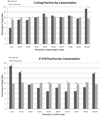The code within the code: microRNAs target coding regions
- PMID: 20372064
- PMCID: PMC2936675
- DOI: 10.4161/cc.9.8.11202
The code within the code: microRNAs target coding regions
Abstract
The coding sequence of a protein must contain the information required for the canonical amino acid sequence. However, the redundancy of the genetic code creates potential for embedding other types of information within coding regions as well. In a genome-wide computational screen for functional motifs within coding regions based on evolutionary conservation, highly conserved motifs included some expected motifs, some novel motifs and coding region target sites for known microRNAs, which are generally presumed to target 3' untranslated regions (UTRs) (www.SiteSifter.org). We report here an analysis of published proteomics experiments that further support a functional role for coding region microRNA binding sites, though the effects are weaker than for sites in the 3' UTR. We also demonstrate a positional bias with greater conservation for sites at the end of the coding region, and the beginning and end of the 3' UTR. An increased effectiveness of microRNA binding sites at the 3' end of transcripts could reflect proximity to the poly(A) tail or interactions with the 5' terminal 7mGpppN "cap", which is physically adjacent to this region once the message is circularized. The effectiveness of 3' UTR sites could reflect a cooperative role for RNA binding proteins. Finally, increased microRNA conservation near the stop codon suggests to us the possible involvement of proteins that execute nonsense-mediated decay, since this process is activated by tagging of termination codons with factors that induce transcript degradation.
Figures


References
Publication types
MeSH terms
Substances
Grants and funding
LinkOut - more resources
Full Text Sources
Miscellaneous
